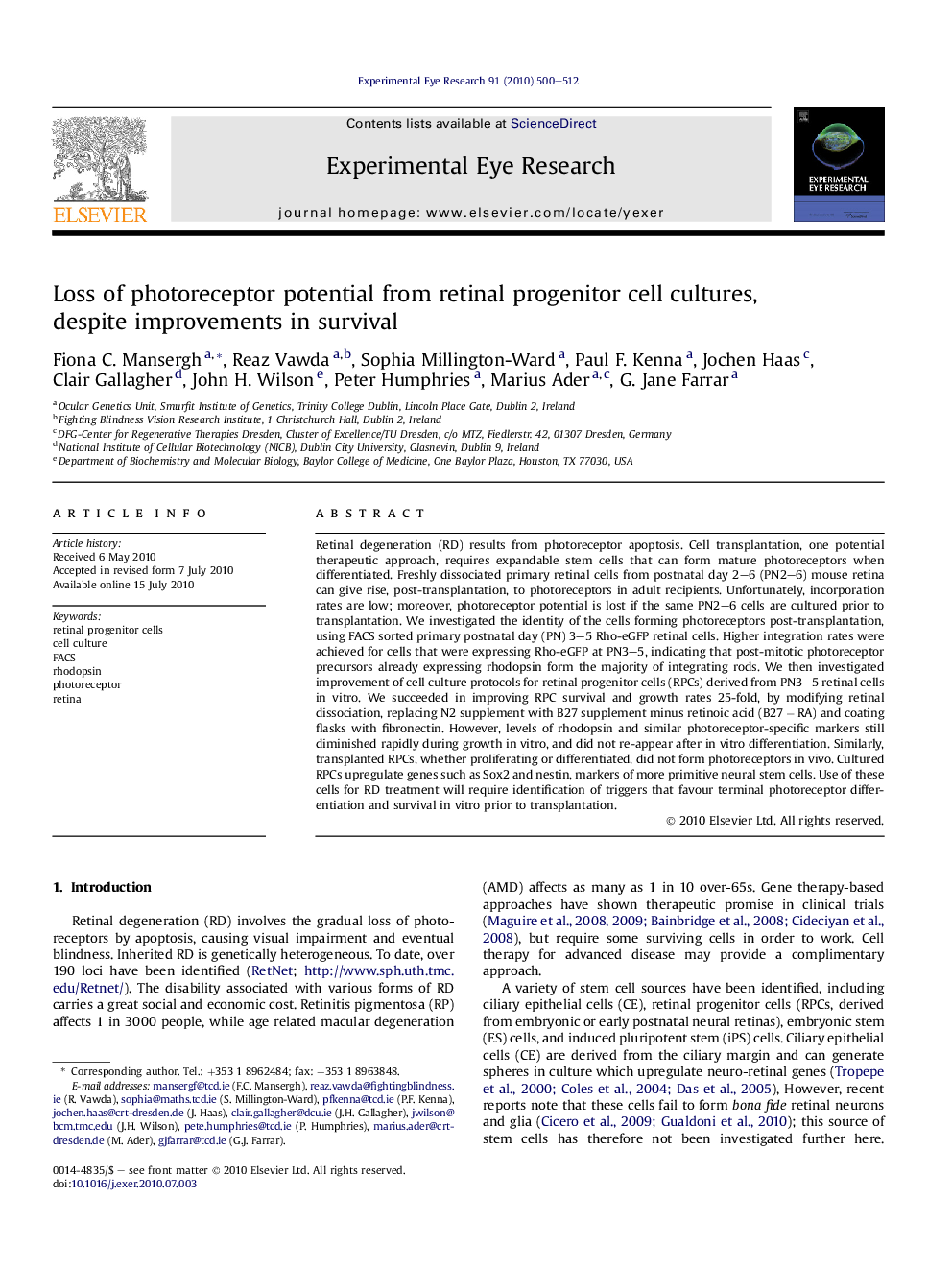| کد مقاله | کد نشریه | سال انتشار | مقاله انگلیسی | نسخه تمام متن |
|---|---|---|---|---|
| 4011777 | 1261163 | 2010 | 13 صفحه PDF | دانلود رایگان |

Retinal degeneration (RD) results from photoreceptor apoptosis. Cell transplantation, one potential therapeutic approach, requires expandable stem cells that can form mature photoreceptors when differentiated. Freshly dissociated primary retinal cells from postnatal day 2–6 (PN2–6) mouse retina can give rise, post-transplantation, to photoreceptors in adult recipients. Unfortunately, incorporation rates are low; moreover, photoreceptor potential is lost if the same PN2–6 cells are cultured prior to transplantation. We investigated the identity of the cells forming photoreceptors post-transplantation, using FACS sorted primary postnatal day (PN) 3–5 Rho-eGFP retinal cells. Higher integration rates were achieved for cells that were expressing Rho-eGFP at PN3–5, indicating that post-mitotic photoreceptor precursors already expressing rhodopsin form the majority of integrating rods. We then investigated improvement of cell culture protocols for retinal progenitor cells (RPCs) derived from PN3–5 retinal cells in vitro. We succeeded in improving RPC survival and growth rates 25-fold, by modifying retinal dissociation, replacing N2 supplement with B27 supplement minus retinoic acid (B27 − RA) and coating flasks with fibronectin. However, levels of rhodopsin and similar photoreceptor-specific markers still diminished rapidly during growth in vitro, and did not re-appear after in vitro differentiation. Similarly, transplanted RPCs, whether proliferating or differentiated, did not form photoreceptors in vivo. Cultured RPCs upregulate genes such as Sox2 and nestin, markers of more primitive neural stem cells. Use of these cells for RD treatment will require identification of triggers that favour terminal photoreceptor differentiation and survival in vitro prior to transplantation.
Research highlights1) We investigated the identity of the freshly dissociated, postnatal day 3–5 retinal cells that can form photoreceptors post-transplantation, using FACS sorted primary postnatal day (PN) 3–5 Rho-eGFP retinal cells. Higher integration rates were achieved for cells that were expressing Rho-eGFP at PN3–5, indicating that post-mitotic photoreceptor precursors already expressing rhodopsin form the majority of integrating rods. 2) We have succeeded in improving RPC survival and growth rates 25-fold, by modifying retinal dissociation, replacing N2 supplement with B27 supplement minus retinoic acid (B27 − RA) and coating flasks with fibronectin. 3) However, levels of rhodopsin and similar photoreceptor-specific markers still diminished rapidly during growth in vitro, and did not re-appear after in vitro differentiation: improved culture conditions do not improve rod precursor survival in culture. Transplanted RPCs, whether proliferating or differentiated, did not form photoreceptors in vivo. 4) Cultured RPCs upregulate genes such as Sox2 and nestin, markers of more primitive neural stem cells. Use of these cells for RD treatment will require identification of triggers that favour terminal photoreceptor differentiation and survival in vitro prior to transplantation. 5) Integration of cultured cells in the inner plexiform and ganglion cell layers may imply utility in therapies for glaucoma, LHON and other retinal disorders that do not result from photoreceptor degeneration.
Journal: Experimental Eye Research - Volume 91, Issue 4, October 2010, Pages 500–512